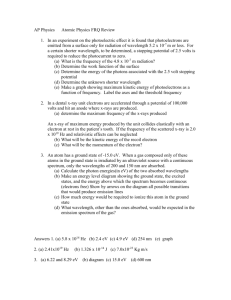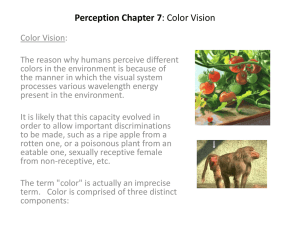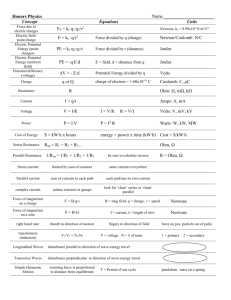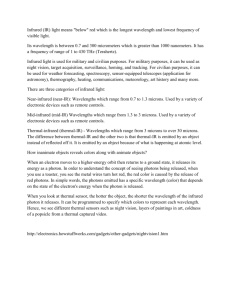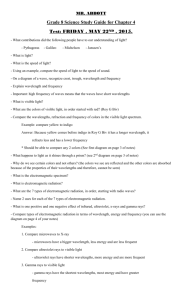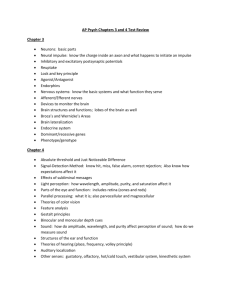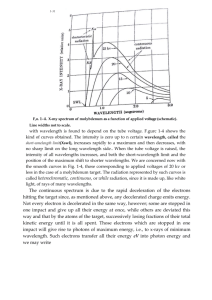Perceiving Color
advertisement
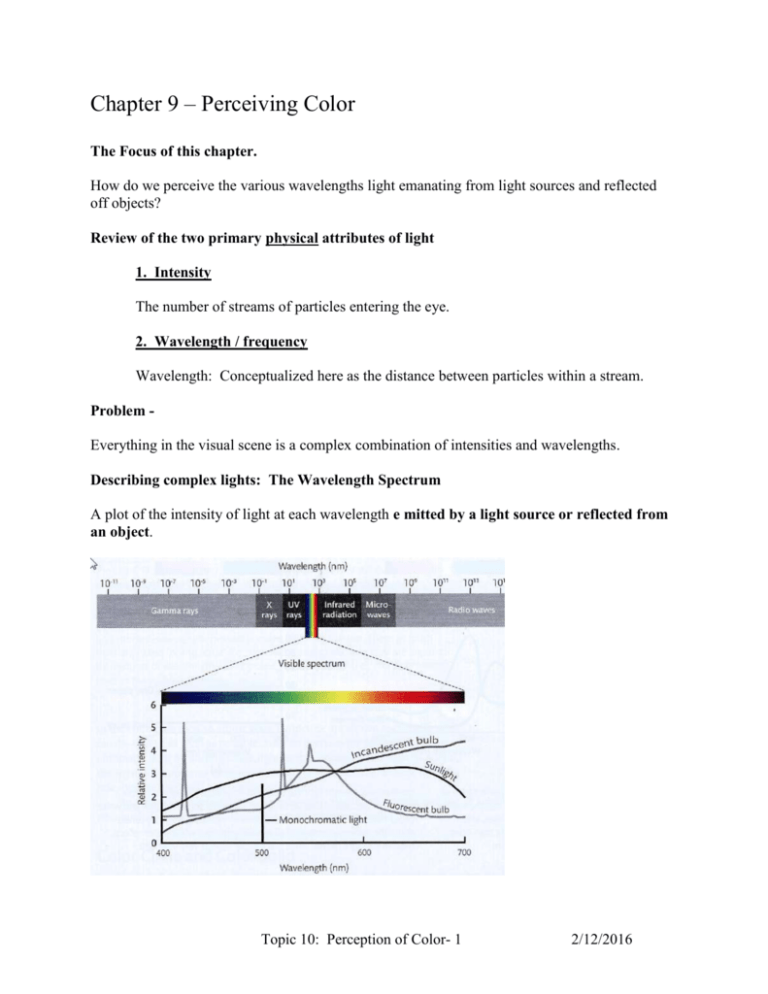
Chapter 9 – Perceiving Color The Focus of this chapter. How do we perceive the various wavelengths light emanating from light sources and reflected off objects? Review of the two primary physical attributes of light 1. Intensity The number of streams of particles entering the eye. 2. Wavelength / frequency Wavelength: Conceptualized here as the distance between particles within a stream. Problem Everything in the visual scene is a complex combination of intensities and wavelengths. Describing complex lights: The Wavelength Spectrum A plot of the intensity of light at each wavelength e mitted by a light source or reflected from an object. Topic 10: Perception of Color- 1 2/12/2016 Examples of spectra of various objects. A plot high at the right indicates that the object appears red or yellow. A spike in the graph, if high enough, may determine the predominant hue of the object. . Terms associated with experience of wavelength. White, gray, and black objects share the same form of curve – flat. The white flat curve is simply higher than a gray flat curve. Hue – That aspect of experience which depends most directly on wavelength. What we typically call “color”. Saturation – The amount of hue relative to white / absence of white. Saturated blue: Unsaturated blue: Brightness – The intensity of light (number of particle streams) emanating from what is being viewed. Low brightness: Higher brightness: Main points so far 1. How to read a spectrum. 2. Rough understanding of relationship of a spectrum to the appearance of an object. 3. Hue 4. Saturation 5. Brightness Topic 10: Perception of Color- 2 2/12/2016 Toward an understanding of how we perceive intensity and wavelength . . . What was known 300+ years ago - in 1672, for example. (From Blake & Sekular) The belief in the 1600s was that white light was the purest light. All other lights were “dirty”, like dirty clothes. Isaac Newton discovered evidence challenging this belief in 1672 at age 29. His evidence was based on experiments conducted in a shed on his farm, using prisms. He found that white sunlight could be separated into colored components. His ideas were greeted with such fury and disdain that he waited more than 30 years before publishing his complete work on these topics in a treatise called Opticks, in 1704. By that time Newton's genius was nearly universally acknowledged so he had little to fear. Even so, Goethe, a philosopher and poet expressed shock at the patent absurdity of Newton's prism demonstration. Goethe considered Newton a "Cossack" for denying the purity of white light. Goethe argued that Newton's decomposition of white into colors implied that white was no more special than any other color. Goethe even wrote the following poem arguing against Newton’s position. Friends, escape the dark enclosure, where they tear the light apart and in wretched bleak exposure twist and cripple Nature's heart. Superstitions and confusions are with us since ancient times leave the specters and delusions in the heads of narrow minds. (Translated by Weisskopf and Worth, in Weisskopf, 1976) Goethe obtained a prism and attempted to verify some of Newton's claims. He never correctly repeated what Newton had done. For example, Goethe looked directly through the prism but failed to see a spectrum of colors, leading him to believe that Newton, in addition to being a Cossack, was a charlatan. Goethe went further. He enlisted the services of a young man, Arthur Schopenhauer, who would later become a famous philosopher in his own right. Goethe interested Shopenhauer in his ideas about light and color, and persuaded him to continue the assault on Newton. Using Goethe's own optical equipment, the younger man began to do experiments with light (Birren, 1941, p. 214). Unfortunately for Goethe, though, these experiments convinced Schopenhauer that Newton had been right after all. Sunlight does consist of many different colors. Main points . . . 1. Beliefs of everyone about basic experiences were once quite different from those we have now. 2. Challenging accepted beliefs can be very difficult. Topic 10: Perception of Color- 3 2/12/2016 Combining hues. - Additive vs. Subtractive mixtures of hues - G9 p 202 Additive mixing: The wavelengths striking the eye are those in all components. Additive mixing is achieved by shining two or more lights on the same white surface. For example, adding pure blue and yellow lights results in both short wavelengths (blue) and longish wavelengths (yellow) striking the eye. Eye Lights B Experience is that resulting from stimulation by both short and long wavelengths – white, as we’ll see later. Y White surface Subtractive mixing: The wavelengths of white light reflected to the eye are those not absorbed by either component. Achieved by mixing paints, blue and yellow, for example. Put blue paint which reflects short wavelengths and absorbs long on a surface. Then put yellow paint which reflects long wavelengths on the same surface. The only wavelength reflected is medium – perceived as green. Short +middle wavelengths reflected 400 500 600 700 Middle +long wavelengths reflected 400 Yellow paint on a surface 500 600 700 Only middle wavelength reflected. 400 Blue paint on a surface 500 600 Topic 10: Perception of Color- 4 Blue + Yellow paint on a surface 700 2/12/2016 Additive vs. Subtractive tatoos Practical applications of mixing rules . . . Additive Television displays are of 1000s of tiny dots of hue. There are 3 sets of dots, intermixed. At a typical viewing distance, the individual dots are not visible – only the additive combinations of the hues. Subtractive Ink jet printers. Three different inks are mixed using rules of subtractive mixing. Topic 10: Perception of Color- 5 2/12/2016 Basic color phenomena that must be accounted for by a theory of color perception. 1. Color Matching. G9 p 204 Almost any hue experience associated with a single wavelength can be mimicked by the appropriate additive mixture of 3 carefully chosen “primary” wavelengths. Look carefully at the individual lights. Each has a different wavelength. Newton devised a graphical method that can be used to show the results of additive color mixing. He found that a “wheel” representation of the colors was most appropriate. The center of the wheel represents white. Each point on perimeter of the wheel represents an experienced hue. The farther a point is from the center, the more saturated it is. Using the wheel for additive mixtures The result of additive mixture of two hues is represented on the wheel by a) drawing a line on the color wheel between the two existing hues b) picking a point on that line that represents the relative intensities of the two hues c) The location point on the circle is the experienced hue. This can be generalized to the combination of 3 (or more) hues. Note that equal mixtures of Blue and Yellow yield white, as do equal mixtures of Red and Bluish Green. This is a characteristic of additive mixtures. Adding colors on opposite sides of the wheel yields white. Topic 10: Perception of Color- 6 2/12/2016 2. Color deficiencies. G9 p 208 1st Major Category: Most color deficiencies are associated with an inability to distinguish what we call red from what we call green. Protanopia – Looking ahead, we now believe this occurs when persons lack L cones Deuteranopia – We now believe this occurs when persons lack M cones A 2nd major category is an inability to distinguish various types of blue from yellow Tritanopia – We now believe this occurs when persons lack S cones A 3rd major category is the inability to distinguish color at all. Rod monochromacy Cone monochromacy – We now believe this occurs when persons lack two cone types. A theory of color perception must explain why we find the three categories of color deficiency. How things may look to persons with various types of color deficiency . . . A dichromat is a person with only 2 types of cones. Topic 10: Perception of Color- 7 2/12/2016 Aside: Testing for color deficiency – Problem – most objects that reflect different wavelengths also reflect different overall intensities. Solution: Create figures in which different parts reflect different wavelengths but are of the same brightness. Typical stimulus – A figure of dots whose wavelengths are different from the background dots is created, but the Intensities of the figure dots are equal to intensities of the background dots. Dvorine Pseudo-Isochromatic plates or Ishihara Color Vision Test. Y1 p 181. Under the appropriate lighting conditions, persons with a red-green deficiency will see this plate as a collection of circles all of the same hue. Those with normal color vision will see the number 67. Topic 10: Perception of Color- 8 2/12/2016 Trichromatic Theory of Color Vision – G9 p 204 Basic Premise: Color perception is the result of the activity of three different classes of receptor, each one most sensitive to a different wavelength of light. The activity of the three receptors is combined somehow and it is the combination that determines the experienced hue. According to the theory, the experienced hue is like the total score on a test with multiple choice and essay. You can get 100% on the multiple choice and 80% on the essay and have a 90% total. Or you can get 80% on the multiple choice and 100% on the essay and have 90%. So, either collection of individual scores yields the same combination – 90%. Originally proposed by Thomas Young in 1801. Elaborated and quantified by Hermann Helmholtz in 1909. Behavioral evidence supporting trichromatic theory Color matching phenomena Each experienced hue the result of the combination of activity of the three receptor types. Any collection of wavelengths that could yield the same combination would have the same hue. Color deficiency phenomena Difficulty in distinguishing red from green was due to a missing receptor for long or medium wavelengths. Difficulty in distinguishing blue was due to a missing receptor for short wavelengths. Difficulty in distinguishing all colors was due to missing two or more receptors. Physiological evidence for Trichromatic Theory G9 p 204 Evidence for the existence of 3 types of cones was provided by microspectro-photometry in the early 1960s – 160 years after trichromatic theory was first proposed by Young. This research found 3 classes of receptor in the retinas of humans S cones: Most sensitive to light of 443 nm. Experienced as violet. M cones: Most sensitive to light of 543 nm. Experienced as green. L cones: Most sensitive to light of 574 nm. Experienced as greenish yellow. An interesting historical note is that using carefully designed color matching experiments, Helmholtz in the early 1900s proposed receptor wavelength sensitivities that were remarkably near the wavelength sensitivity curves found 60 years later. Topic 10: Perception of Color- 9 2/12/2016 Approximate numbers of the cones found in the 1960s . . . S: M L 1 million/eye 2.5 million/eye 2.5 million/eye But numbers of M and L cones differ across persons. Fig 5.12 Spatial distribution of the cones: L&M cones: Distributed throughout the fovea. S: Scarce in the fovea. This explains the fact that letters written in blue or violet are most difficult to perceive. New evidence on the Number of Cone Types FROM THE JULY-AUGUST 2012 ISSUE of DISCOVER MAGAZINE The Humans With Super Human Vision An unknown number of women may perceive millions of colors invisible to the rest of us. One British scientist is trying to track them down and understand their extraordinary power of sight. By Veronique Greenwood|Monday, June 18, 2012 http://discovermagazine.com/2012/jul-aug/06-humans-with-super-human-vision . (I have a copy of this if it can’t be downloaded.) Topic 10: Perception of Color- 10 2/12/2016 Why do we need two or more cone types? G9 p 206 Response of a single cone to different wavelengths . . . 100 Could be 480 or 550. 50 400 500 600 700 Problem: The single cone type gives the same response to multiple different wavelengths combinations. So they would be perceived as the same. So a creature (like us) depending on the response of a single cone type could not disteinguish different wavelengths and different intensities from each other. But two cones, with slightly different wavelength preferences could distinguish different wavelengths . . Since 1 is at 10and 2 is at 2, it must be 480. Having two cone types would enable us to make some discriminations. Having three types enables us to make many more. Topic 10: Perception of Color- 11 2/12/2016 Color Vision facts that cannot be accounted for in terms of trichromatic theory G9 p 210 3. Afterimages and color contrast Afterimages: Prolonged exposure to a single hue followed by viewing a gray field yields the experience of an afterimage that is of a different hue. Hue of the afterimage corresponds to the hue of stimulus. Red stimulus -> Green afterimage. Green stimulus -> Red afterimage Blue stimulus -> Yellow afterimage Yellow stimulus -> Blue afterimage. Stare at this object for 60 seconds. Then stare at a blank wall. View for 60 seconds, then look at a blank surface. Color Contrast: The apparent saturation of red is heightened when viewed next to green. Same for blue/yellow combinations. 4. Lack of certain hue experiences: Reddish Green Blueish Yellow 5. The categories of hue experience . . . This suggests that we must have 6 categories of response – six responses that are somehow qualitatively different from each other. Perhaps 6 different neuron types? Topic 10: Perception of Color- 12 2/12/2016 Opponent Processes Theory G9 p 210 Proposed by Ewald Hering who published between 1878 and 1920, around the time of Helmholtz. Proposed 3 color processes 1. A Red / Green system/process that responded in one way to light perceived as red and in the opposite way to light perceived as green. 2. A Yellow / Blue system/process that responded in one way to light perceived as yellow and in the opposite way to light perceived as blue. 3. A white/black or achromatic system/process that responded in one way to high intensity light and in the opposite way to low intensity light. This system did not respond differentially to different wavelengths. He called these processes. They were called opponent processes because they were presumed to respond in two ways, each way opposing the other. The perceived hue of an object is determined by the strength and direction of response of the three processes. If the R/G process is responding strongly in the R direction, the object will be perceived as having Red in it. If the Y/B process is perceived as responding strongly in the Y direction, the object will be perceived as having Yellow in it. And if the W/B process is responding strongly in the W direction, the object will be perceived as bright. So here’s how the opponent process system would account for the 6 hues Hue Red Orange Yellow Green Blue Violet Red/Green Red Red Neither Green Neither Red Blue/Yellow Neither Yellow Yellow Neither Blue Blue Note that two, orange, and violet, of the 6 categories of hue are “combination” hues – represented by responses of both the R/G and the B/Y system. Topic 10: Perception of Color- 13 2/12/2016 Phenomena the Opponent Processes theory could account for 4. Afterimages. For example, prolonged viewing one hue causes fatigue of that response, so that the response in the opposite direction predominates when a neutral surface is viewed. For example, prolonged viewing of a red stimulus caused the R/G process to become “fatigued” and caused the “green” response to predominate when a neutral surface is viewed. 5. Lack of certain color experience. The R/G process cannot exhibit both a Red and a Green response at the same time, so we have no experience of reddish green 6 The categories of color experience, e.g., red, green, blue, and yellow plus mixtures – Orange = R+Y, Violet = R+B Phenomena Opponent Processes theory could not account for 1. Matching. 2. Deficiencies. Arguments against and evidence for the Opponent Processes Theory Arguments against The theory proposed that something in the brain responded in two different directions. There was no evidence at the time that any nervous system component could do that. The belief at the time was that nervous system components were either quiescent or active, so they could respond in only one direction – becoming active. There was no evidence for an “opposite” response. Physiological evidence supporting the Opponent Processes theory Scientists studying the brain in the middle and late 1900s found that most neurons respond continually, at what is called a base rate of activity. This opened the possibility for two types of resonse of a neuron – 1) a decrease in rate or 2) an increase in rate. DeValois and colleagues in the 1960s found neurons in the LGN that responded by increasing firing rate to long wavelengths and decreasing firing rate to short wavelength lights. His research found two general types of neuron - R/G neurons and B/Y neurons. Response of B/Y neuron Response of G/R neuron Rate Of Activity Wavelength Topic 10: Perception of Color- 14 2/12/2016 Current Theory – G9 p 212 Now, virtually all researchers believe that 1) We have 3 types of cones and it is the output of these cones that begins the process of color perception. So trichromatic theory was correct in 1801 – 200+ years ago. 2) We have opponent processes that respond in opposite ways to R/G and B/Y. So, opponent processes theory was correct – 100 years ago. So how can this be? The current belief is that the synaptic connections of receptors and bipolar and amacrine cells in the retina result in retinal ganglion cell responses that are either Red vs. Green or Blue vs. Yellow. Some ganglion cells are R/G. Others are B/Y. Below is one possibility that is frequently presented. Excitation is indicated by a (>). Inhibition is indicated by a ( | ). G9 p. 212 S M Type of Cone L B/Y R/G Blue+ / YellowOpponent Process Red + / Green Opponent Process Response is S – (M+L)/2 Response is L-M Topic 10: Perception of Color- 15 2/12/2016 Taking it to the extreme – why not have more than 3 receptor types? How about 300 types? The above explorations have shown that the more types of receptors we have, the greater the number of different wavelengths we can discriminate. Why not have 100s of receptor types? Why stop at 3? Suppose the visual system had 300 different types of receptor, each tuned to a different wavelength. 402 403 405 404 406 700 407 401 400 Response of each receptor type Wavelength Each receptor would signal a different wavelength. The response of a given receptor would signal the intensity of the light at the wavelength to which the receptor was most sensitive. That is, the wavelength of light would be represented by which receptor was most active. The intensity of the light would be represented by the level of activity of that one receptor. The sum of the responses of all the receptors would signal the overall intensity of the light. This system would be capable of analyzing the visual world into ALL its wavelengths and intensities. What would be good about having 300+ cone types? 1. The world would be incredibly more colorful. Wavelengths that we now perceive as being the same, e.g., 620 and 625 are both perceived as red, would instead be perceived as being quite different hues. 2. We could eat the time in order to feed all the receptors needed to process the wavelengths. Topic 10: Perception of Color- 16 2/12/2016 What would be bad about having 300 receptor types? 1. To maintain acuity at all wavelengths, each type of receptor would have to be distributed equally across the whole retina. This means the retina would have to be 100+ times bigger than it is now to accommodate the 300 different types of receptor. Only then would we have acceptable acuity at all wavelengths. Current retina with 100 million receptors Expanded retina with 300*100 = 30 billion receptors Also, there would be up to 100 times as many other types of cells – bipolar, ganglion, horizontal, and amacrine – drastically increasing the nutritional demands of the retina. So we’d have to have huge eyes, big enough to hold 300 times more receptors, bipolar cells, horizontal cells, amacrine cells, and ganglion cells. 2. The LGN would also have to be 100 times bigger to process the information from the 300 receptor types. So we’d have huge bulges on the sides of our heads where the LGN is located. 3. There would have to be 100 times as many cortical cells to process the 300 times greater amount of information form the 100 receptor types. The backs of our heads would have to be huge, to contain all the neurons necessary to process information from 300+ receptor types. Here’s how we might look. Huge LGN from added millions of neurons to received added information from retina - forming a bump on the side of the head Huge occipital lobe hanging over the back of the neck. Huge eyes required to contain the added receptors and their associated bipolar, amacrine, and ganglion cells. Brace to hold up the huge occipital lobe. 4. Every surface would be multicolored. We’d notice thousands of details that we don’t now notice. We’d probably be driven crazy by the myriad colors of surfaces that we now perceive as being all the same color. 5. Of course we’d have to have names for all the different colors. A whole grade in elementary school would have to be devoted to just learning the color names. ENOUGH COLOR, ALREADY!!! Topic 10: Perception of Color- 17 2/12/2016 Constancies – G9 p 214 Constancy: The stability of experience in spite of changes in the external stimulation. The hardest work that the nervous system does may be that done to create constancies – keeping our experience of the world constant in spite of constantly changing external stimulation. The latest DARPA challenge is to create a robot that could be of service in places (such as nuclear power plant) that humans could not go. A major problem with the design of these robots is making them so they don’t fall over all the time. Types of constancy. 1. Shape/Form constancy. The experience of shapes as being “the same” or unchanged even though the actual stimulation on our retinas changes drastically. See how all four views of the same object below are experienced as being “our text”. 2. Size constancy. The perception of objects as having constant size in spite of large changes the actual size of the image on the retinas. More on this in the chapter on depth/size perception. 3. Lightness Constancy. The perception of objects as having constant lightness in spite of massive changes in the amount of light reflected from them. 4. Color Constancy. The perception of objects as having constant hue in spite of large changes in the spectrum reflected from them. Shape and size constancies are the only two we can “recognize”. We are essentially oblivious to lightness and color constancies. Without careful thought and the use of instruments to measure intensity and the spectrum, we wouldn’t even know that the last two existed. Topic 10: Perception of Color- 18 2/12/2016 Color Constancy – G9 p 214-215 The perception of objects as having constant hue even though the spectrum of wavelengths reflected by them changes drastically. Examples 1. Spectral Reflectance Curve of a sheet of typing paper viewed in either sunlight or incandescent light. Curve in incandescent light – much more long wavelength reflected. Curve in sunlight– much more short wavelength reflected. Yet in either light, typing paper appears “white”. It doesn’t appear “blue” in sunlight and “yellow or red” in incandescent light. 2. Spectrum of a blue sweater in sunlight and in incandescent light. Reflectance curve of blue sweater in Sunlight Reflectance curve of same blue sweater in Incandescent light The appearance of the sweater appears essentially unchanged even though the amount of short wavelength light reflected from it changes dramatically. Topic 10: Perception of Color- 19 2/12/2016 Explanations for color constancy – how our visual system lies to us about wavelength changes. 1. Chromatic adaptation. G9 p 215 The visual system adapts to prolonged exposure to a particular pattern of wavelengths, so if the environment contains an excess of a particular wavelength, the visual system becomes less sensitive to that wavelength. So, for example, in incandescent light, in which there is a lot of long wavelength (orangish) light, adaptation makes the visual system less sensitive to long wavelength light, make the appearance of objects in that light look about the same as their appearance in sunlight which has less long wavelength light than incandescent light. This might explain why the insides of houses look normal when we’re in them but look yellow when viewed from the street at night. Don’t do this. When you’re in the street, your visual system has not adapted to the long wavelengths, and hence, objects in the house appear yellow. Chromatic adaptation certainly exists and does affect our perception of color. See DEMONSTRATION, G9 p 215. Research suggests that chromatic adaptation does play a role on color constancy. G9 p 215 2. Memory color. G9 p 217 Hue experienced is based on our memory of what the hue of the object was in other circumstances. An apple appears red in all illuminations because it’s been perceived as red so often. There is evidence that memory has some, but not a huge effect on our experience of color. Topic 10: Perception of Color- 20 2/12/2016 3. Effect of the surroundings. G9 p 216 This explanation assumes that the visual system automatically determines the average amount of each wavelength reflected from all surfaces and uses this as an estimate of the spectral distribution of the lighting in a particular situation. Hue experience associated with an object arises from an automatic comparison of object wavelengths with distribution of lighting in the situation. This suggests that, for example, what is perceived as blue is that which reflects the shortest wavelength of all the objects in a scene, regardless of the actual distrubtion of wavelengths. The hue of an object is based on a comparison of its wavelengths with the wavelengths of surrounding objects. So, experienced hue is the result of a comparison of wavelengths across the visual scene. Topic 10: Perception of Color- 21 2/12/2016 Using Habituation /Dishabituation to assess infant color vision Q: How do we know whether or not an infant sees a newly presented object as being a different hue from a previously presented object? Present a stimulus repeatedly to an infant and record the amount of time the infant looks at the stimulus. Eventually, the infant habituates – quits looking at the stimulus. Then present the test stimulus. If the infant does not look at the test stimulus, then the conclusion is that it appears the same as the habituating stimulus. But if the infant dishabituates – looks at the new stimulus, that’s an indication that it the test stimlulus is perceived as different. 4 month old infants. 510 nm Topic 10: Perception of Color- 22 2/12/2016 Topic 10: Perception of Color- 23 2/12/2016
